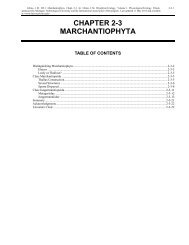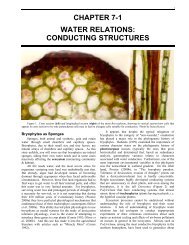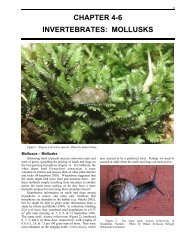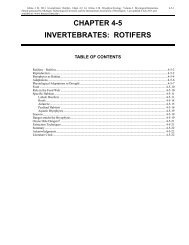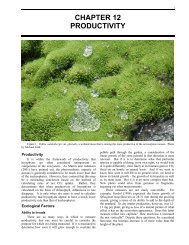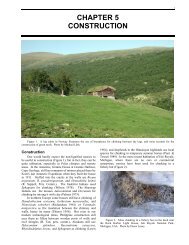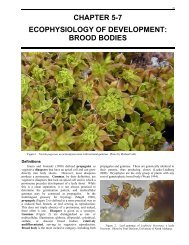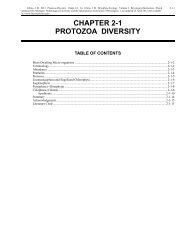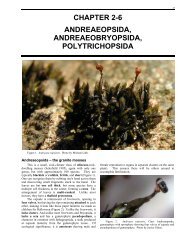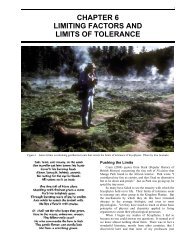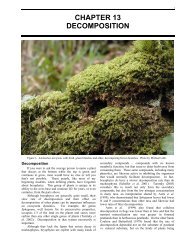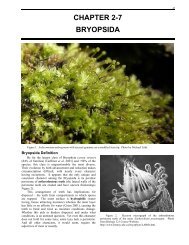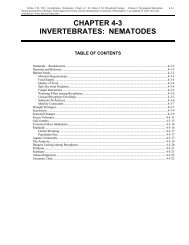Chapter 8-5 Translocation and Transport - Bryophyte Ecology
Chapter 8-5 Translocation and Transport - Bryophyte Ecology
Chapter 8-5 Translocation and Transport - Bryophyte Ecology
Create successful ePaper yourself
Turn your PDF publications into a flip-book with our unique Google optimized e-Paper software.
CHAPTER 8-5NUTRIENT RELATIONS:TRANSLOCATION AND TRANSPORT43Figure 1. Bazzania trilobata <strong>and</strong> other bryophytes growing together. Note the dead tissue in the lower right part of the clump,where nutrient sinks can be mobilized to supply growing apical tissues. Such clumps can play a significant role in the distribution offorest nutrients. Photo by Michael Lüth.<strong>Translocation</strong> <strong>and</strong> <strong>Transport</strong>One of the most poorly understood abilities ofbryophytes by "vascular" botanists is the ability ofbryophytes to transport nutrients within the plant. Makingthe assumption that transport of nutrients occurs throughvascular tissue (xylem <strong>and</strong> phloem), they have assumedthat the "non-vascular" bryophytes are unable to movesubstances from one part of the plant to another. Hence,the assumption has been that as bryophytes die (Figure 1),decomposition will return the component nutrients. Butwhile bryophytes lack tracheids, vessels, <strong>and</strong> sieve cells,they do not lack the ability to transport substances from onepart of the plant to another, i.e. translocation. In somecases, such as Polytrichum, they actually transportsubstances through their leptoids (phloem-like cells; Figure2) <strong>and</strong> hydroids (xylem-like cells; Figure 2). Thosemosses such as Polytrichum with well-developed leptoidsform a leptome, similar to the cylinder of phloem in a treetrunk. The collective hydroids in the center of the stemform the hydrome, also known as the hydram. But it isclear that lack of even these special conducting cells is nodeterrent to transport or to translocation in bryophytes.Hence, we can find nutrient elements in a number oflocations within <strong>and</strong> upon the plant (Table 1).One aid to the transport of substances from cell to cellis the presence of plasmodesmata in the cell walls(Mahmoud 1965; Oliver & Bewley 1984). Theseconnecting threads permit substances to move from cell tocell without traversing cell membranes, although themovement is undoubtedly slower than that of themovement of water in the interstitial capillary spaces of cellwalls.
44 <strong>Chapter</strong> 8-5: Nutrient Relations: <strong>Translocation</strong> <strong>and</strong> <strong>Transport</strong>Figure 2. Cross section of Polytrichum juniperinum <strong>and</strong> longitudinal section of Atrichum undulatum stem to illustrate parts ofcentral str<strong>and</strong> (leptoids <strong>and</strong> hydroids) <strong>and</strong> stem structures. Drawings by Margaret Minahan, based on Hébant (1977).Table 1. Element locations in bryophytes. Based on Brown(1982).1. in particles trapped by leaves2. in solution on exterior & in matrix of cell wall3. as ions bound to external exchange or chelating sites& on plasma membranes4. in solution in cytoplasm & vacuoles5. as insoluble substances in cytoplasm & vacuoles6. in leptome (especially Polytrichaceae)Duckett <strong>and</strong> Ligrone (2003) list several specificexamples in their note "What we couldn't have done if we'dstayed in Europe: Selection <strong>and</strong> serendipity in the SouthernHemisphere." They demonstrated the presence of "foodconductingcytology" (i.e. food conducting cells) in thewidespread groups of Hookeriaceae, Neckeraceae,Orthotrichaceae, <strong>and</strong> Sphagnum, as well as in mostcaulonemata <strong>and</strong> rhizoids. Furthermore, it is present in theaxes of the primitive moss Takakia <strong>and</strong> the moss-like leafyliverwort Haplomitrium, as well as being widespread inMarchantialian thalli.We have seen that bryophytes move water aboutinternally as well as externally. There is ample evidencethat they likewise move nutrients, hormones, <strong>and</strong>photosynthate within the plant, <strong>and</strong> of course, nutrients getmoved externally with the water as well. Within stems,leptoids may serve to enhance nutrient movement; Hébant(1974) demonstrated that "sieve elements" of Polytrichumcommune exude liquid. Polytrichaceae have highlyspecialized leptoids with polarized cytoplasmicorganization within the axis. In the endohydric mossPolytrichastrum alpinum, labeled 14 C supplied as CO 2traveled at the rate of 7.5 cm h -1 within the stems of apopulation in Point Barrow, Alaska, whereas in sometracheophytes, the rate may be little more than 1 cm perhour for water movement. In other mosses, includingSphagnum, less specialized parenchyma cells of the stem<strong>and</strong> seta carry out similar functions.But it does not require the sophisticated structures ofPolytrichum to move substances within mosses. Alpert(1989) demonstrated that photoassimilate moved from theleaves to the stem bases <strong>and</strong> even underground stems inGrimmia laevigata, a predominantly ectohydric moss, buthe was unable to demonstrate any movement of mineralnutrients. In Rhytidiadelphus squarrosus (Figure 3) therate of movement from old to young tissues is inverselyrelated to the pool size, so that small segments moveproportionally more nutrients to the developing tissues(Wells & Brown 1996), following a source-to-sinkprinciple. When side branches were removed fromHylocomium splendens to adjust the nutrient pool, loss ofthose branches led to lower concentrations of K + , Mg ++ ,Ca ++ , <strong>and</strong> Zn ++ in the young shoots, indicating theimportance of movement from older to younger tissues(Brümelis & Brown 1997). These young segments did,however, produce more branches when branches on maturesegments were removed.Figure 3. Rhytidiadelphus squarrosus. Photo by MichaelLüth.
<strong>Chapter</strong> 8-5: Nutrient Relations: <strong>Translocation</strong> <strong>and</strong> <strong>Transport</strong> 45Consider the impact on our thinking when wediscovered that even Sphagnum moves nutrients from olderto younger tissues. Such ability permits it to live inextremely low nutrient habitats, yet have sufficientnutrients to sustain life <strong>and</strong> growth for centuries.Particularly in habitats such as true bogs, where allnutrients arrive through precipitation, the Sphagnum is ableto trap <strong>and</strong> hold 50-90% of the deposited N (Li & Vitt1997). This leaves little for tracheophytes, <strong>and</strong> Aldous(2002) found that they received less than 1% of that Nsupply. Rydin <strong>and</strong> Clymo (1989) had already demonstratedthat Sphagnum is able to move both P <strong>and</strong> C upwardthrough 7cm of stem length. If the Sphagnum holds <strong>and</strong>relocates its N within its own tissues, the tracheophyteshave little ability to compete for the N they need. In fact,Aldous (2002) demonstrated that Sphagnum capillifoliumdoes indeed translocate its N supply to growing tissueswithin the capitulum. In a relatively clean site in Maine, itmoved 11-32% of its N <strong>and</strong> in an N-polluted site, it moved64-83% within the 2-cm segments examined. Gerdol(1990) found that N, P, <strong>and</strong> K in Sphagnum ofombrotrophic bogs in the Alps were directly absorbed inthe chlorophyllose cells, but also partly recycled fromageing tissues to the growing capitulum.Sphagnum is also able to transport C <strong>and</strong> P rapidlywithin the stems (Rydin & Clymo 1989). Rydin <strong>and</strong>Clymo (1989) demonstrated that Sphagnum papillosumtranslocated 14 C in the soluble fraction from older parts ofthe moss to the apex, with very little transfer into theinsoluble fraction, to neighbors, or into the gas phase. Infact, the transfer of 14 C to the capitulum from lowerportions of the plant was about equal to that lost from thecapitulum through respiration. The capitulum alsotransferred about twice as much 14 C to the insolublefraction <strong>and</strong> about half as much to its neighbors. Rydin<strong>and</strong> Clymo reasoned that the ~1500 perforations in a singlecell wall probably house plasmodesmata that permit thecell-to-cell transfer.Bakken (1995) suggested that the reason theacrocarpous moss Dicranum majus (Figure 4) has a low Ndem<strong>and</strong> <strong>and</strong> persistence of N in young tissues at sites withhigh N is that it moves N from older to younger tissues.Pleurozium schreberi (Figure 5), a large, pleurocarpous,feather moss with no central str<strong>and</strong> or special conductingcells, is even able to move its nutrient supply about. And itis selective about it. It is able to move the soluble K + <strong>and</strong>Mg ++ from plant base to apex, but, as in tracheophytes, theinsoluble Ca ++ is non-translocatable (Bates 1979). In fact,the concentration of Ca ++ increases with distanced fromapex, assumedly reflecting its longer time to accumulatethere. As a component of the cell wall, the concentration ofCa ++ would increase as the cell sap was lost after death.But that is not the full explanation of its increasingconcentration there. Ca ++ supplied below the Pleuroziummats moves up the stems externally, taking advantage ofthe exchange sites <strong>and</strong> capillary movement of water (Bates& Farmer 1990). If it behaves like Sphagnum, broken cellswill expose more exchange sites on the insides of cells,permitting Ca ++ to be bound.It appears that Pleurozium could be a nitrogen sink. Itabsorbs N in quantities apparently beyond its needs(Raeymaekers 1987; Raeymaekers & Glime 1990). And asmight be expected, K + is easily leached out of the mossunder stress of simulated acid rain <strong>and</strong> desiccation(Raeymaekers & Glime 1990). Thus, it appears that thismoss that can provide 100% cover in Jack pine (Pinusbanksiana) <strong>and</strong> other northern <strong>and</strong> boreal forests couldhave a major impact on nutrient flux. As an accumulator ofN, it could become a sink, or it could release its excess loadslowly over time. With its propensity for losing K + whensuffering membrane damage from desiccation, Pleurozium<strong>and</strong> other bryophytes could be a means of sequestering K +from throughfall, then releasing it later, or they could hoardit until rain comes, releasing it at a time when the K + ismost vulnerable to loss from the roots by leaching <strong>and</strong>runoff. On the other h<strong>and</strong>, the very presence of the thickmoss mat of Pleurozium could prevent that runoff loss,slowly releasing the K + to the soil as the rainfall eventprogresses. Our underst<strong>and</strong>ing of this process is as yet toolimited to know the net impact.Figure 4. Dicranum majus with sporophytes. Photo byMichael Lüth.Figure 5. Pleurozium schreberi. Photo by Michael Lüth.It seems that bryophytes differ among species in theirnutrient mobilities, <strong>and</strong> in which nutrients go where.Eckstein <strong>and</strong> Karlsson (1999) compared the movement ofN in the pleurocarpous moss Hylocomium splendens <strong>and</strong>the acrocarpous Polytrichum commune. In both species,the current year of growth served as a sink for N. In P.commune the older segments showed a net loss of N fromJune to September, a loss the authors interpreted asresorption of N to the subterranean rhizome. By contrast,in H. splendens, the one-year-old segments, like theyoungest segments, increased in N, whereas the oldersegments lost 50% of the N initially measured there. All
46 <strong>Chapter</strong> 8-5: Nutrient Relations: <strong>Translocation</strong> <strong>and</strong> <strong>Transport</strong>the N lost from the older segments could be identified inthe two youngest segments. Thus, as the three-year-oldsegments of H. splendens died <strong>and</strong> became brown, Nmoved upward in the plant to younger segments. It isinteresting that one species behaved as trees do in the fall(P. commune), moving the N downward, while the otherbehaved as trees or crop plants do in spring (H. splendens),moving it to the new growth.When the moss is enriched, the translocated load canlikewise be enriched. When input of N as 15 NH 15 4 NO 3 wascompared at low <strong>and</strong> high levels, Sphagnum capillifoliumincreased its annual N translocation from 11% to 80%(Aldous 2002). Aldous (2002) estimated that translocationcontributes 0.5-11% of the annual N budget of the moss.This observation is consistent with the observation that Ntranslocation is higher in the high N deposition Adirondacksites than in the low deposition Maine sites. However, theMaine sites had a low water table <strong>and</strong> severe droughtduring the year of measurement <strong>and</strong> thus we cannot assumethat the greater movement in the Adirondacks was due tothe greater concentration.Even the aquatic mosses behave like tracheophytes intheir transfer of nutrients from older to younger segments.The soluble N, P, <strong>and</strong> K are concentrated in the apicalregions of Fontinalis squamosa <strong>and</strong> F. antipyretica,whereas the less soluble Ca, Mg, <strong>and</strong> Fe increase towardthe base (Mártínez Abaigar et al. 2002). However, thereare two possible explanations for this: N, P, <strong>and</strong> K aremoved from older to younger tissues, just as they are intracheophytes, or younger, more active tissues activelyuptake these three nutrients. Mártínez Abaigar <strong>and</strong>coworkers considered both factors to be contributing.Surprisingly, even the heavy metals travel. Rühling<strong>and</strong> Tyler (1970) found that in Hylocomium splendensmetals such as Cu, Fe, <strong>and</strong> Mn are taken in by the youngtissues <strong>and</strong> moved to the older ones.Sucrose <strong>Transport</strong>We know that the leptome – that part of the stem ofsome mosses composed of leptoids, Figure 6 – conductsassimilates, <strong>and</strong> that sucrose applied to the outside of theplant ends up there (Trachtenberg & Zamski 1978). Intracheophytes, many other substances can travel in thephloem, the tracheophyte counterpart of the leptome. But,in a bryophyte, how does one examine what is travelling ina tube so small it cannot be seen without a microscope, forwhich preparation is likely to disrupt the whole process?One of the most fascinating techniques (to me at least)in all biology is the use of aphids to determine what travelsin conducting tissues. Well, even bryophytes can haveaphids! And Thomas <strong>and</strong> Lombard (1991) have takenadvantage of this fascinating tool to determine just whattravels in the leptoids of Polytrichum commune (Figure 7).The aphid, Myzodium modestum, a moss aphid <strong>and</strong> thusquite small, inserts a needlelike stylet into the mossconducting tissue. Thomas <strong>and</strong> Lombard found that whenP. commune leaves are treated with 14 C-sucrose, 17-34% ofthe labelled carbon can be detected in 2-15 aphids withinfour hours. In fact, these aphids are so efficient at removalthat the movement of sucrose to other parts of the plant <strong>and</strong>to shared underground rhizomes is reduced from its normal4% to 1% or less.Figure 6. Cross section of Polytrichum stem. Photo byIsawa Kawai.In Polytrichum commune, labelled 14 C from sucroseapplied externally quickly appeared in the growing stemapex, young leaves, bud initials, <strong>and</strong> underground axes, allsinks for this C source (Reinhart & Thomas 1981). Itappears that the C is more likely to move acropetally(toward the tip) than basipetally (toward the base).Nevertheless, labelled C travels from the leaves bothacropetally (Eschrich & Steiner 1967) to the growing shootapex <strong>and</strong> basipetally to underground rhizomes (Collins &Oechel 1974). The movement of externally applied sucroserequires ATP as an energy source for uptake, followed bymovement from the apoplastic free space into theleptome, similar to phloem loading in tracheophytes(Reinhart & Thomas 1981).The movement of externally applied labelled 14 C inPolytrichum commune, <strong>and</strong> by implication also the plant'sown photosynthate, reaches several other leaves within twohours <strong>and</strong> reaches the rhizome within 72 hours or less(Reinhart & Thomas 1981). Experiments usingradioactively labelled 14 C demonstrate that C moves inmosses in a source-to-sink fashion, as it does intracheophytes. Furthermore, movement to the undergroundaxis in this <strong>and</strong> other mosses allows translocation toneighboring members of a clone (Thomas et al. 1988,1990), either directly through rhizomatal connections orindirectly through carbohydrates that escape into thesoil/moss medium <strong>and</strong> can be absorbed. The carbon is bothused <strong>and</strong> stored, with labelled carbon appearing in starches<strong>and</strong> cell wall polysaccharides one week <strong>and</strong> six weeks later,respectively (Thomas et al. 1988).Figure 7. Polytrichum commune, a moss with extensiveinternal conduction. Photo by Michael Lüth.
<strong>Chapter</strong> 8-5: Nutrient Relations: <strong>Translocation</strong> <strong>and</strong> <strong>Transport</strong> 47As you might expect, the patterns of translocation willvary between species of bryophytes, even in the sameecosystem. For example, near Fairbanks, Alaska, in aPicea mariana forest, Polytrichum commune retained themost of labelled 14 C after 2 hours, while Sphagnumsubsecundum retained the least (Skré et al. 1983).However, after 35 days, it was Sphagnum subsecundumthat had the highest fraction of radiolabelled 14 C in thebrown tissues, with Polytrichum commune coming insecond. The two pleurocarpous feather mosses,Hylocomium splendens <strong>and</strong> Pleurozium schreberi, had noconsistent pattern of translocation after 2 hours or 35 days.All four species exhibited high loss of labelled 14 C torespiration (presumably photorespiration) during the first 2hours, which coincided with the peak of the growth season.It is likely that most bryophytes have some sort ofconduction specialization within the stem. Sphagnum hasrecently revealed its internal system within the centralportion of the stem (Ligrone & Duckett 1998). This systemis manifest by the absence of large central vacuoles,spindle-shaped nucleus with prominent axial system ofendoplasmic microtubules, membrane-bound tubules <strong>and</strong>vesicles, a high frequency of plasmodesmata in thecrosswalls, all characteristics that are common to foodconductingcells. These same characters are also known inthe food-conducting cells of Bryopsida <strong>and</strong> suggest anorganization specialized for symplastic transport. They arealso known in rhizoids <strong>and</strong> caulonemata of mosses <strong>and</strong> inthallus parenchyma cells of liverworts (Ligrone et al.2000).Leptome <strong>Transport</strong>Trachtenberg <strong>and</strong> Zamski (1978) determined that inaddition to photosynthate, the leptome of Polytrichumjuniperinum moves ionic solutes such as sulfate <strong>and</strong> lead,whereas the chelated forms of iron <strong>and</strong> lead move in thehydroids. Ions from the moss surface are able to moveacross the cortex through the free space between the cells(apoplastically). The leptome actually acts much like theendodermis of a root in serving as a barrier between thehydrome <strong>and</strong> the cortex. Thus, it becomes a site wheretoxic ions accumulate <strong>and</strong> are not transported to the rest ofthe plant. In their experiments, Trachtenberg <strong>and</strong> Zamskifound that Pb moved in this way, accumulating in theleptome, but no Pb was found within the cytoplasm of anycortex cells. The leptoids, on the other h<strong>and</strong>, had heavydeposits. Hence, it appears that an active symplasticmechanism controls the movement of solutes <strong>and</strong> heavymetals in much the same way as the endodermis of a root.It is interesting that the stem of a moss has developed thissame safeguard.To get the same toxicity with the EDTA (chelated) Cu<strong>and</strong> Zn requires 500X more concentrated solution than withthe ionic form. The chelation changes the mode oftranslocation within the bryophyte, with bound (chelated)ions moving in the free space to the leptome. Theseobservations are consistent with the structure of the leptoidcells, which have large nuclei <strong>and</strong> an abundance ofendoplasmic reticula (Eschrich & Steiner 1967; Hébant1976), both permitting the cells to exercise high metabolicactivity.A similar phenomenon for copper <strong>and</strong> zinc has beenseen in gemmae of Marchantia polymorpha <strong>and</strong>protonemata of Funaria hygrometrica (Coombes & Lepp1974). Copper was more toxic than zinc to both species atlevels above 8 mg L -1 . Protonemata did not grow <strong>and</strong>spores did not germinate in Funaria hygrometrica. Even at1 mg L -1 , few buds formed in Funaria. In zinc, it producedrounded protonemal cells that could be interpreted as broodcells, known to occur as a response to unfavorableconditions (Van Andel 1952). In Marchantia, rhizoidformation on gemmalings was inhibited at 1 ppm copper.Zinc did not cause any noticeable changes. In thesebryophytes, there was a delicate line between essentiallevels <strong>and</strong> toxic levels of copper, with levels above 0.5 mgL -1 being deleterious to development.External <strong>Translocation</strong>As mosses die, especially those with an upright habit,ions can be moved externally from basal portions to upperportions rather easily (Brehm 1971; Brown 1982). Dead<strong>and</strong> dying lower tissues release ions that go into solution inthe external surface film. Evaporative loss of water fromthe capitulum of Sphagnum <strong>and</strong> from apices of Bryopsida,generally termed transpiration, causes water to moveupward through the external capillary spaces. As it does, itcarries with it the ions leaked from dead <strong>and</strong> dying cells.These can then be absorbed on the exchange sites of theapex. Brown (1982) considered that the higherconcentrations of Ca ++ , K + , <strong>and</strong> Mg ++ in Mnium hornum inhigher light intensities (Thomas 1970) could be the resultof increased transpiration.Sporophyte ConductionAs we have already seen for water, the sporophyte getsnutrients, hormones, <strong>and</strong> an energy supply from thegametophyte through the sporophyte foot (Courtice et al.1978). Some of the evidence for this transfer is indirect.For example, in Polytrichum formosum, a decrease in theamino acid arginine in the gametophyte is coincidental withan increase in the sporophyte (Whel 1975). Whelsuggested that this parallels the tracheophyte movement ofN from a mature to young organ.The internal structure reveals transfer cells at thegametophyte-sporophyte junction (Figure 8; Lal &Chauhan 1981). The transfer cells are found in the foot ofthe sporophyte <strong>and</strong> in the adjacent gametophyte <strong>and</strong> areendowed with an extensive <strong>and</strong> complex wall labyrinth.Ligrone <strong>and</strong> Renzaglia (1990) demonstrated that thehornwort Dendroceros tubercularis, as in other hornworts,is endowed with dense protein deposits in the vacuoles ofboth gametophyte transfer cells <strong>and</strong> the sporophyte foot.The structure of the transfer cells suggests a function in themovement of metabolites from the gametophyte to thesporophyte by their numerous mitochondria <strong>and</strong> intenseenzyme activity, especially of phosphatases <strong>and</strong> somerespiratory enzymes (Lal & Chauhan 1981).The junction cells are the first to differentiate in theyoung sporophyte (Kwok & Rushing 1999). The transfercells on both sides of the junction have plastids <strong>and</strong> starchcontent, with numerous small vacuoles <strong>and</strong> lipid deposits inthe junction cells, further supporting the role of this regionin transfer of nutrients to the sporophyte.Caussin et al. (1983) demonstrated that sporophytes ofPolytrichum formosum absorb the amino acids glycine,threonine, <strong>and</strong> α-aminoisobutyric acid through the
48 <strong>Chapter</strong> 8-5: Nutrient Relations: <strong>Translocation</strong> <strong>and</strong> <strong>Transport</strong>haustorial (absorptive) foot, using the transfer cells.Removal of the haustorial foot significantly reduced theabsorption of these amino acids into the sporophyte.(Figure 10) transfers sugars from the photosyntheticsporophyte to the gametophyte, where it is used by itsNostoc partner (Stewart & Rodgers 1977).As nutrients cross the placenta (gametophytesporophyteinterface) into the sporophyte, there is anotheropportunity for nutrient discrimination. Basile et al. (2001)found that the gametophyte accumulated much greaterquantities of Pb <strong>and</strong> Zn than did the sporophyte in Funariahygrometrica. These two elements accumulated in theplacental transfer cells on both gametophytic <strong>and</strong>sporophytic sides. When the two metals were applied inthe lab, Basile <strong>and</strong> coworkers found that the twogenerations had different accumulation quotients.Figure 8. Transfer cell showing wall labyrinth. Computerdrawnfrom photo in Lal <strong>and</strong> Chauhan (1981).Chevallier et al. (1977) demonstrated that radioactiveorthophosphate moved from the gametophyte to the capsule<strong>and</strong> eventually to the spores in Funaria hygrometrica.However, once the capsule turned from green to brown,indicating maturity, the original 18% transfer rate turned tozero. But this is not the only potential means for thesporophyte to get its nutrients. It is, at least in Funariahygrometrica (Figure 9), able to absorb nutrients directlythrough its capsule, hence opening the possibility that itgets some nutrients from dust <strong>and</strong> rainwater.Figure 9. Capsules of Funaria hygrometrica. Photo byJanice Glime.It appears that K + moves into the developingsporophyte rapidly, whereas Ca ++ , which is generallyimmobile, moves more slowly (Brown 1982). In Brown'sstudy, as the gametophyte senesced, its K + diminished <strong>and</strong>the concentrations of Ca ++ <strong>and</strong> Mg ++ increased, presumablydue to movement of K + from the senescing gametophyte tothe young sporophyte, followed by Ca ++ <strong>and</strong> Mg ++occupying the vacated exchange sites on the gametophyte.Marsh <strong>and</strong> Doyle (1981) demonstrated that sugars aretransported actively by the transfer cells. A more startlingdiscovery is that the sporophyte of Anthoceros punctatusFigure 10. Thallus of Anthoceros punctatus with youngsporophytes. Photo by Des Callaghan.SummaryAcrocarpous mosses may receive considerableinput from the substrate through upward movementexternally <strong>and</strong> subsequent internal movement. Cationexchange sites hold nutrients on leafy surfaces <strong>and</strong>facilitate uptake <strong>and</strong> discrimination between ions.Further active processes are able to distinguish ionsformed by N, P, <strong>and</strong> K from more exchangeable cationssuch as those of Ca ++ or Mg ++ , <strong>and</strong> they are generallyable to maintain relatively constant levels of theseessential nutrients despite changes in environmentalconcentrations. <strong>Bryophyte</strong>s use pathways both throughcells (symplastic) <strong>and</strong> between cells (apoplastic) tomove internal substances, just as do the tracheophytes.And they may even have a filter similar to theendodermis, in the form of a leptome, at least in thePolytrichaceae. They also behave like tracheophytes inmoving essential ions such as those formed by N, P,<strong>and</strong> K from older to younger parts, whereas less solubleions like Ca ++ remain in older tissues. Their ability toacquire ions from rainwater <strong>and</strong> hold them in theirtissues makes them a sink for forest nutrients, but some,especially K + , may be released in heavy rainfallfollowing a dry period, returning the nutrients to theforest floor as a pulse.Sucrose is transported in the leptome, as well as .Radiolabelled carbon quickly appears in the stem apex,young leaves, bud initials, <strong>and</strong> underground axes. Mostof the movement is toward the apex (acropetal), butsome also moves to the base (basipetally). Somereaches other stems in the clone. The leptome also
<strong>Chapter</strong> 8-5: Nutrient Relations: <strong>Translocation</strong> <strong>and</strong> <strong>Transport</strong> 49moves ionic solutes, whereas the chelated forms movein the hydroids.Sugars <strong>and</strong> nutrients move from the gametophyteto the sporophyte through the transfer cells in thesporophyte foot.Their ability to move nutrients from old to youngtissues <strong>and</strong> to store them both externally <strong>and</strong> internallyraises serious questions about their role in the nutrientcycling in the habitats where they are abundant.AcknowledgmentsI appreciate the contributions of undergraduate PhilGaudette <strong>and</strong> M. S. student Jennifer Jermalowicz Jones fortheir critical reading of the manuscript from theperspectives of students interested in nutrient relationshipsof bryophytes.Literature CitedAldous, A. R. 2002. Nitrogen translocation in Sphagnummosses: Effects of atmospheric nitrogen deposition. NewPhytol. 156: 241-253.Alpert, P. 1989. <strong>Translocation</strong> in the nonpolytrichaceous mossGrimmia laevigata. Amer. J. Bot. 76: 1524-1529.Andel, O. M. Van. 1952. Germination of spores <strong>and</strong>development of primary <strong>and</strong> secondary protonema ofFunaria hygrometrica. Trans. Brit. Bryol. Soc. 2: 74-81.Bakken, S. 1995. Effects of nitrogen supply <strong>and</strong> irradiance ongrowth <strong>and</strong> nitrogen status in the moss Dicranum majus fromdifferently polluted areas. J. Bryol. 18: 707-721.Basile, A., Cogoni, A. E., Bassi, P., Fabrizi, E., Sorbo, S.,Giordano, S., <strong>and</strong> Castaldo Cobianchi, R. 2001.Accumulation of Pb <strong>and</strong> Zn in gametophytes <strong>and</strong>sporophytes of the moss Funaria hygrometrica (Funariales).Ann. Bot. 87: 537-543.Bates, J. W. 1979. The relationship between physiologicalvitality <strong>and</strong> age in shoot segments of Pleurozium schreberi(Brid.) Mitt. J. Bryol. 60: 339-351.Bates, J. W. <strong>and</strong> Farmer, A. M. 1990. An experimental study ofcalcium acquisition <strong>and</strong> its effects on the calcifuge mossPleurozium schreberi. Ann. Bot. 65: 87-96.Brehm, K. 1971. Ein Sphagnum-bult als Beispiel einernaturlichen Ionenaustauschersaule. Beitr. Biol. Pflanzen 47:287-312.Brown, D. H. 1982. Mineral nutrition. In: Smith, A. J. E. (ed.).<strong>Bryophyte</strong> <strong>Ecology</strong>, Chapman & Hall, London, pp. 383-444.Brümelis, G. <strong>and</strong> Brown, D. H. 1997. Movement of metals tonew growing tissue in the moss Hylocomium splendens(Hedw.) BSG. Ann. Bot. 79: 679-686.Caussin, C., Fleurat-Lessard, P., <strong>and</strong> Bonnemain, J. L. 1983.Absorption of some amino acids by sporophytes isolatedfrom Polytrichum formosum <strong>and</strong> ultrastructuralcharacteristics of the haustorium transfer cells. Ann. Bot. 51:167-173.Chevallier, D., Nurit, F. <strong>and</strong> Pesey, H. 1977. Orthophosphateabsorption by the sporophyte of Funaria hygrometricaduring maturation. Ann. Bot. 41: 527-531.Collins, N. J. <strong>and</strong> Oechel, W. C. 1974. The pattern of growth <strong>and</strong>translocation of photosynthate in a tundra moss, Polytrichumalpinum. Can. J. Bot. 52: 355-363.Coombes, A. J. <strong>and</strong> Lepp, N. W. 1974. The effect of Cu <strong>and</strong> Znon the growth of Marchantia polymorpha <strong>and</strong> Funariahygrometrica. Bryologist 77: 447-452.Courtice, G. R. M., Ashton, N. W., <strong>and</strong> Cove, D. J. 1978.Evidence for the restricted passage of metabolites into thesporophyte of the moss Physcomitrella patens (Hedw.) Br.Eur. J. Bryol. 10: 191-198.Duckett, J. G. <strong>and</strong> Ligrone, R. 2003. What we couldn't havedone if we'd stayed in Europe: Selection <strong>and</strong> serendipity inthe Southern Hemisphere! Bull. Brit. Bryol. Soc. 80: 19-21.Eckstein, R. L. <strong>and</strong> Karlsson, P. S. 1999. Recycling of nitrogenamong segments of Hylocomium splendens as compared withPolytrichum commune: implications for clonal integration inan ectohydric bryophyte. Oikos 86: 87-96.Eschrich, W. J. <strong>and</strong> Steiner, M. 1967. AutoradiographischeUntersuchungen zum Stofftransport bei Polytrichumcommune. Planta 74: 330-349.Gerdol, R. 1990. Seasonal variations in the elementconcentrations in mire water <strong>and</strong> in Sphagnum mosses on anombrotrophic bog in the southern Alps. Lindbergia 16: 44-50.Hébant, C. 1974. The phloem (leptome) of bryophytes. In:Aronoff, S., Dainty, J., Gorham, P. R., Srivastava, L. M., <strong>and</strong>Swanson, C. A. (eds.). Phloem <strong>Transport</strong>. Plenum Press, N.Y., pp. 211-215.Hébant, C. 1976. Studies on the development of the conductingtissue-system in the gametophytes of some Polytrichales. III.Further observations on leptoids, with particular reference totheir endoplasmic reticulum. Protoplasma 87: 79-90Hébant, C. 1977. The Conducting Tissues of <strong>Bryophyte</strong>s. J.Cramer, Lehre, Germany, 157 pp. + 80 Plates.Kwok, L. Y., <strong>and</strong> Rushing, A. E. 1999. An ultrastructural <strong>and</strong>developmental study of the sporophyte-gametophyte junctionin Ephemerum cohaerens. Bryologist 102: 179-195.Lal, M. <strong>and</strong> Chauhan, E. 1981. Transfer cells in the sporophyte –gametophyte junction of Physcomitrium cyathicarpum Mitt.Protoplasma 107: 79-83.Li, Y. <strong>and</strong> Vitt, D. H. 1997. Patterns of retention <strong>and</strong> utilizationof aerially deposited nitrogen in boreal peatl<strong>and</strong>s.Ecoscience 4(1): 106-116.Ligrone, R. <strong>and</strong> Duckett, J. G. 1998. The leafy stems ofSphagnum (Bryophyta) contain highly differentiatedpolarized cells with axial arrays of endoplasmicmicrotubules. New Phytol. 140: 567-579.Ligrone, R. <strong>and</strong> Renzaglia, K. S. 1990. The sporophytegametophytejunction in the hornwort, Dendrocerostubercularis Hatt. (Anthocerotophyta). New Phytol. 114:497-505.Ligrone, R., Duckett, J. G., <strong>and</strong> Renzaglia, K. S. 2000.Conducting tissues <strong>and</strong> phyletic relationships of bryophytes.Philosoph. Trans. Roy. Soc. London B 355: 795-813.Mahmoud, M. I. 1965. Protoplasmics <strong>and</strong> drought resistance inmosses. Ph. D. Thesis, Univ. Calif., Davis.Marsh, B. H. <strong>and</strong> Doyle, W. T. 1981. <strong>Transport</strong> in transfer cellsof a bryophyte. Plant Physiol. 67 (Suppl. 4): 24.Mártínez Abaigar, J., García Alvaro, M. A., Beaucourt, N., <strong>and</strong>Núñez Olivera, E. 2002. Combined seasonal <strong>and</strong>longitudinal variations of element concentrations in twoaquatic mosses (Fontinalis antipyretica <strong>and</strong> F. squamosa).Nova Hedw. 74: 349-364.Oliver, M. J. <strong>and</strong> Bewley, J. D. 1984. Desiccation <strong>and</strong>ultrastructure in bryophytes. Adv. Bryol. 2: 91-131.Raeymaekers, G. 1987. Effects of simulated acidic rain <strong>and</strong> leadon the biomass, nutrient status, <strong>and</strong> heavy metal content ofPleurozium schreberi (Brid.) Mitt. J. Hattori Bot. Lab. 63:219-230.Raeymaekers, G. <strong>and</strong> Glime, J. M. 1990. Effect of simulatedacidified canopy throughfall on the composition of percolate<strong>and</strong> the chlorophyll content from Pleurozium schreberi(Brid.) Mitt. Mém. Soc. Roy. Bot. Belg. 12: 67-76.
50 <strong>Chapter</strong> 8-5: Nutrient Relations: <strong>Translocation</strong> <strong>and</strong> <strong>Transport</strong>Reinhart, D. A. <strong>and</strong> Thomas, R. J. 1981. Sucrose uptake <strong>and</strong>transport in conducting cells of Polytrichum commune.Bryologist 84: 59-64.Rühling, A. <strong>and</strong> Tyler, G. 1970. Sorption <strong>and</strong> retention of heavymetals in the woodl<strong>and</strong> moss Hylocomium splendens(Hedw.) Br. et Sch. Oikos 21: 92-97.Rydin, H. <strong>and</strong> Clymo, R. S. 1989. <strong>Transport</strong> of carbon <strong>and</strong>phosphorus compounds about Sphagnum. Proc. Roy. Soc.London B 237: 63-84.Skré, O., Oechel, W. C., <strong>and</strong> Miller, P. M. 1983. Patterns oftranslocation of carbon in four common moss species in ablack spruce (Picea mariana) dominated forest in interiorAlaska. Can. J. Forest Res. 13: 869-878.Stewart, W. D. P. <strong>and</strong> Rodgers, G. A. 1977. The cyanophytehepaticsymbiosis. II. Nitrogen fixation <strong>and</strong> the interchangeof nitrogen <strong>and</strong> carbon. New Phytol. 78: 459-471.Thomas, H. 1970. Ph. D. Thesis, University of Bristol.Thomas, R. J. <strong>and</strong> Lombard, C. S. 1991. Aphid infestation <strong>and</strong>its effects on translocation in Polytrichum commune.Bryologist 94: 1-4.Thomas, R. J., Schiele, E. M., <strong>and</strong> Scheirer, D. C. 1988.<strong>Translocation</strong> in Polytrichum commune (Bryophyta) I.Conduction <strong>and</strong> allocation of photoassimilates. Amer. J.Bot. 75: 275-281.Thomas, R. J., Schiele, E. M., <strong>and</strong> Damberg, D. T. 1990.<strong>Translocation</strong> in Polytrichum commune (Bryophyta). II.Clonal integration. Amer. J. Bot. 77: 1569-1573.Trachtenberg, S. <strong>and</strong> Zamski, E. 1978. Conduction of ionicsolutes <strong>and</strong> assimilates in the leptom of Polytrichumjuniperinum Willd. J. Exper. Bot. 29: 719-727.Wells, J. M. <strong>and</strong> Brown, D. H. 1996. Mineral nutrient recyclingwithin shoots of the moss Rhytidiadelphus squarrosus inrelation to growth. J. Bryol. 19: 1-17.Whel, C. 1975. Quantitative changes in free amino acids inPolytrichum formosum during development. Phytochemistry14: 2337-2340.



